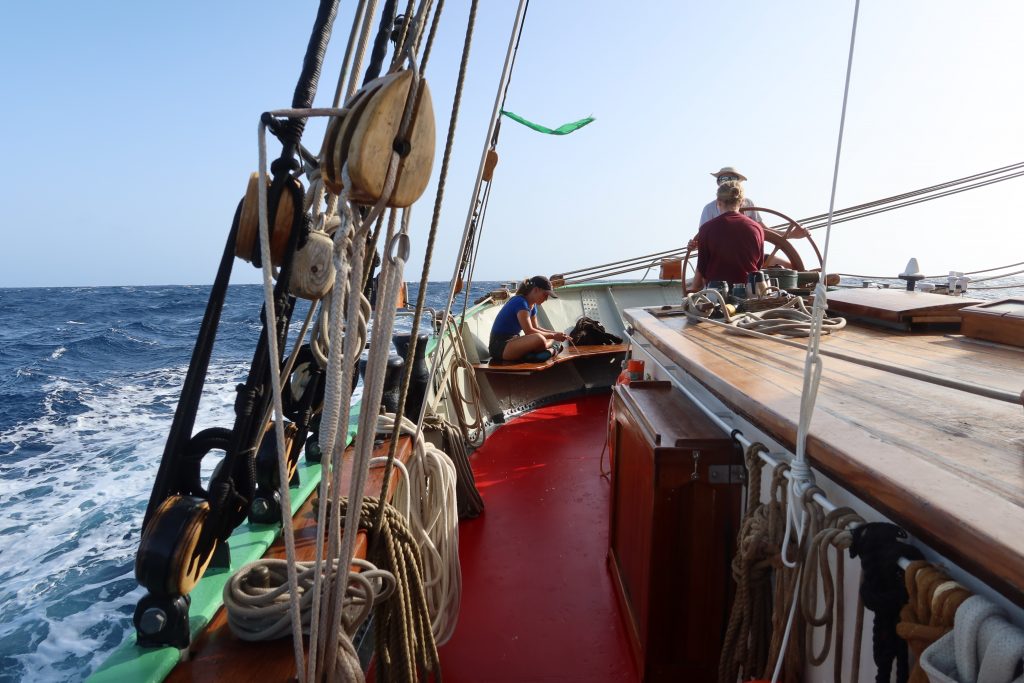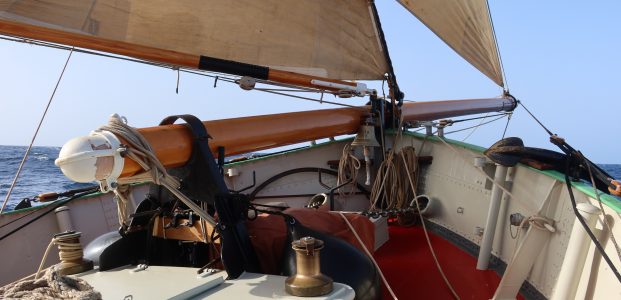Reading: The Salt Path (Raynor Wynn)
Weather: Thunder and lightning and rain overnight clearing to grey cloudy – Wind NW 1-2 shifting N 4-5 mid-afternoon
Thought for the day: What use is a fish which can fly if it flies straight through a hatch into the cabin?
Evening meal: Chicken risotto cooked in white wine
Course: Between 210oC and 250oC depending on wind
Distance covered: At 1600 we had done 423 miles, 3,381 to go (to Brazil)
Flying fish headcount: 4 dead (including 1 baby), 2 alive though one with a headache as it hit the gunwhale as we threw it back!
Just when you think things have settled down and routine has kicked in, everything changes. The night watch had thunder, lightning and rain and then such light winds that they had to tack round to get on the other gybe with the help of the engine. Our morning watch started well with clearing flying fish off the deck. Amazingly one had even managed to fly halfway across the deck and through an open hatch into the cabin – Tinke found that one while cleaning! As it became light we started spotting them regularly. They can fly quite amazing distances and a lot of it upwind, though we guessed that they were flying away from us assuming that we were a predator of some sort. Apparently the record flight for a flying fish is 45 seconds – recorded off Japan. The pattern of flight (or gliding?) is fascinating. Sometimes it looks quite elegant, but at other times they just seem to ricochet randomly off the waves. The landings back into the face of the wave are not what you would call elegant, but if it gets them away from their predators then I guess it is effective. The downside is that in flight, they become a target for the boobies and frigate birds. Their latin name is Exocoetidae, so a little known fact is that Exocet missiles are named after them!
We were then preparing pancakes for breakfast when Jet had to be woken up to get the second generator started. Both generators are required for the cooker. She sorted that and promptly spotted that the bolt through the gooseneck for the main was coming loose, so large hammers, crowbars and spanners started appearing from assorted lockers around the place. Eventually the main had to come down and the boom be pinned in place before it could be driven back into place. The main was rehoisted, but then the clew outhaul jammed and the hammering started again …. The whole process took around two hours, so we had the pancakes just before lunch. Poor Jet missed around 3-4 hours of sleep sorting all these issues.
The rest of the day was generally quieter, though the wind got up quite a bit in the afternoon to a healthy F5, so we were making a cracking speed of around 9 knots but on a course of 250oC – not exactly where we want to go!


